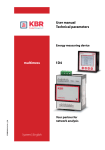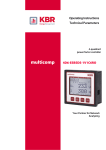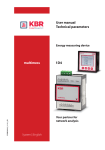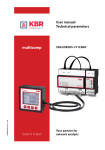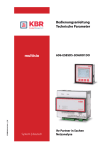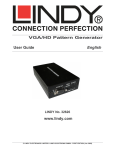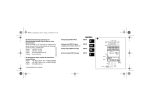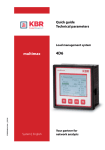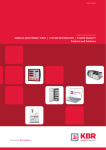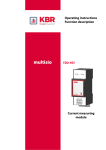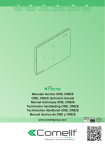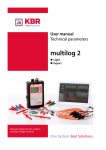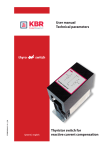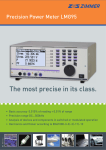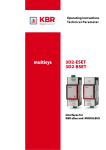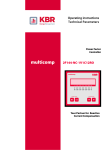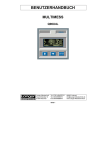Download User manual
Transcript
User manual Technical parameters EDEBDA0202_2212-1_EN multisio System I english 6D6-ESBSDS-5DI6RO1DO Your partner for network analysis © KBR GmbH Subject to change 2 Table of contents KBR multisio 6D6 Table of contents 1 Introduction........................................................................................................... 6 1.1 User manual......................................................................................................... 6 1.2 Intended use........................................................................................................ 6 1.3 Explanation of safety relevant symbols..................................................... 7 1.4 Safety notes.......................................................................................................... 7 1.5 Product liability................................................................................................... 9 1.6 Disposal................................................................................................................. 9 1.7 Serial interface..................................................................................................... 9 1.8 Overvoltage and lightning protection.....................................................10 1.9 Definition of terms...........................................................................................10 2 Installation...........................................................................................................11 2.1 Device assembly...............................................................................................11 2.2 Connection chart..............................................................................................12 2.3 Terminal assignment.......................................................................................13 2.4 Inserting or replacing backup battery:.....................................................14 EDEBDA0202_2212-1_EN 3 Range of functions............................................................................................16 3.1 multisio 6D6 basic module...........................................................................16 3.1 Expansion modules available......................................................................16 3.1.1 multisio 2D2-4DI...........................................................................................16 3.1.2 multisio 2D2-4TI............................................................................................17 3.1.3 multisio 2D2-4AI...........................................................................................17 3.1.4 multisio 1D2-4CI............................................................................................17 3.1.5 multisio 2D2-1TI2RO....................................................................................18 3.1.6 multisio 2D2-4RO..........................................................................................18 3.1.7 multisio 2D2-4DO.........................................................................................18 3.1.8 multimess 1D4 energy measuring module.........................................19 3.2 Two-tariff counter function (HT / LT).........................................................19 3.3 Configurable pulse inputs.............................................................................19 3.4 Configurable pulse output (pulse totalizer)...........................................20 3.5 Serial interface for connection to the KBR eBus....................................21 3.6 Extensive memory functions.......................................................................21 3.7 Synchronization................................................................................................22 3.8 Tariff switching..................................................................................................22 3.9 Software (required for configuring or reading out memories)............................ 22 Rev. 6.00 3 KBR multisio 6D6 Table of contents 4 System operation..............................................................................................23 4.1 Start-up................................................................................................................23 4.1.1 Enabling the scan mode on the device................................................23 4.1.2 LEDs...................................................................................................................24 4.1.3 Reset..................................................................................................................24 4.1.5 Basic configuration when delivered......................................................25 4.2 Storage.................................................................................................................25 4.2.1 Device settings..............................................................................................25 4.2.2 Long-term memory......................................................................................26 4.2.3 Cycle memory................................................................................................26 4.2.4 Event memory................................................................................................27 4.3 Measuring period synchronization............................................................27 4.3.1 Synchronization only by internal clock.................................................27 4.3.2 Synchronization by the energy supplier's synchronous pulse.....28 4.3.3 Synchronization by the KBR eBus...........................................................28 4.3.4 Synchronization at tariff change.............................................................29 6 Technical data.....................................................................................................41 6.1 Technical data multisio 6D6........................................................................41 6.1.2 Device memory ............................................................................................41 6.1.4 Hardware inputs............................................................................................42 6.1.5 Electrical connection...................................................................................42 6.1.6 Hardware outputs.........................................................................................43 6.1.7 Mechanical data............................................................................................43 6.1.8 Dimensioned drawing................................................................................44 6.1.9 Ambient conditions / electrical safety..................................................44 6.1.10 Error detection............................................................................................45 6.2 Technical data of display................................................................................45 4 Rev. 6.00 EDEBDA0202_2212-1_EN 5 Menu overview...................................................................................................30 5.1 Main menus........................................................................................................30 5.2 Pulse counter inputs.......................................................................................31 5.3 Digital outputs..................................................................................................31 5.4 Digital inputs......................................................................................................32 5.5 Analog inputs....................................................................................................32 5.6 Power measurement inputs.........................................................................32 5.7 Input / output status.......................................................................................33 5.8 Error messages..................................................................................................33 5.9 Settings................................................................................................................33 Table of contents KBR multisio 6D6 6.2.1 Power supply..................................................................................................45 6.2.2 Hardware inputs and outputs..................................................................45 6.2.3 Electrical connection...................................................................................45 6.2.4 Mechanical data............................................................................................45 6.2.5 Ambient conditions / electrical safety..................................................46 EDEBDA0202_2212-1_EN Index...........................................................................................................................47 Rev. 6.00 5 KBR multisio 6D6 Introduction 1 Introduction Thank you for choosing this KBR quality product. In order to familiarize yourself with the operation and configuration of the device, we recommend that you read this manual thoroughly, so that you are able to make use of the entire range of functions of this high-quality product. The individual chapters serve to explain the technical details of the device and show how to avoid damage by means of proper installation and commissioning. 1.1 User manual This user manual describes the device version multisio 6D6. This user manual must be accessible for the user at all times (e.g. in the switchgear cabinet). Even when the device is resold to third parties, the manual remains part of the device. Although we used the utmost care in assembling this user manual, we would like to thank you in advance for notifying us about any errors or ambiguous descriptions you might notice. 1.2 Intended use multisio is a modular system for signal recording and processing. Depending on the input or output type, a wide range of functions can be selected. The device enables you to record the pulses of consumption meters and record them both as a continuous meter count and a standard-compliant load profile. Alternatively, a digital input can also be used for summarization (switching protocol) or to record the operating hours. EDEBDA0202_2212-1_EN Up to five expansion modules for a wide range of signal forms can be connected to a system center via ready-made RJ45 cables . 6 Rev. 6.00 Introduction KBR multisio 6D6 1.3 Explanation of safety relevant symbols This user manual contains notes that must be observed for your personal safety and to avoid damage to equipment. These notes are identified by a warning sign or information symbol, depending on the degree of hazard they represent. j Warning "Warning" means that death, major injuries or damage may occur in case the appropriate safety measures are not taken. h Caution " Caution" means that minor injuries or damage may occur in case the appropriate safety measures are not taken. i Note " Note" is an important information on the product, its operation or the respective part of the user manual to which special reference is made. Disclaimer The content of this user manual has been carefully reviewed in terms of the hardware and software described. Certain deviations, however, cannot be excluded, and the manufacturer is not liable for complete conformity. The specifications made in this user manual are checked on a regular basis, necessary corrections will be included in the next revision. 1.4 Safety notes EDEBDA0202_2212-1_EN In order to prevent operating errors, operation of this device is kept as simple as possible. This way, you will be able to quickly start working with the device. In your own interest, however, you should read the following safety notes carefully. Rev. 6.00 7 KBR multisio 6D6 Introduction During assembly, the applicable DIN / VDE regulations must be observed! Power supply connection, setup and operation of the device must only be performed by qualified personnel. Qualified personnel in accordance with the safety notes in this user manual are persons authorized to set up, ground and mark devices, systems and circuits in accordance with applicable standards and regulations. To avoid fire and electrical shock, the device must not be exposed to rain or humidity! Before connecting the device to the power supply, check whether the local power supply conditions comply with the specifications on the nameplate. h Caution A faulty connection can lead to the destruction of the device! When connecting the device, observe the connection chart (see chapter “Connection chart”) and make sure that no voltage is applied to the connection lines. Only use proper wiring material and observe the correct polarity when wiring! In order to ensure proper and safe operation of the product, it must be transported, stored, installed and assembled in accordance with the specifications and operated and maintained carefully. A visibly damaged device must generally be considered unfit for use and disconnected from the power supply! Opening the device may expose live parts. Capacitors in the device may still be loaded, even if the device has been disconnected from all voltage sources. It is generally not allowed to operate an open device! In systems subject to hazard of lightning, lightning protection must be provided for all input and output lines! 8 Rev. 6.00 EDEBDA0202_2212-1_EN Error detection, repair and maintenance work may only be carried out in our facilities or after contacting the service team. Unauthorized opening of the device voids any warranty. Correct operation can no longer be guaranteed! Introduction KBR multisio 6D6 1.5 Product liability You have acquired a high-quality product. In its production, KBR only uses components of the highest reliability and quality. Each device is subject to long-term testing before it is delivered. Regarding product liability, we refer you to our general terms and conditions for electronic equipment, which you can find at www.kbr.de The warranted characteristics of the device only apply for operation in accordance with its intended use! 1.6 Disposal Defective, outdated or no longer used devices must be properly disposed of. At your request, we will dispose of the devices for you. 1.7 Serial interface RS 485 Bus operation The RS485 interface of the multisio 6D6 is designed for operation at the KBR eBus. You can operate one or several multisio 6D6 devices together with the KBR eBus across great distances. Typically, the bus is connected to the computer via the KBR eBus TCP gateway. All bus devices can be configured and displayed with the corresponding KBR® software. We will be glad to provide information on which other devices you can connect to the KBR eBus as well as on the functionality of our software. EDEBDA0202_2212-1_EN Information on the structure and technical parameters of the KBR eBus can be gathered from our installation guide for the KBR eBus. Just send a request for this installation guide. Rev. 6.00 9 KBR multisio 6D6 Introduction 1.8 Overvoltage and lightning protection It is recommended to install overvoltage protection measures to protect our high-quality devices from damage. We also recommend to protect control voltage inputs and pulse lines, if required. 1.9 Definition of terms Below, you will find brief explanations of the terminology used in this manual. Firmware: Operating software implemented in the microcontroller of the multisio 6D6. Load profile memory: Saves the actual values of the measuring periods with timestamp. Measuring period maximum value: The measuring period containing the highest (maximum) value that occurred. Period value: Cumulated value within a measuring period. Measuring period: Refers to the period of time used to form average values. Typical intervals are e.g. 15, 30 or 60 minutes. EDEBDA0202_2212-1_EN DIN rail Busbar in accordance with DIN EN 50022 10 Rev. 6.00 Installation KBR multisio 6D6 2 Installation In this chapter, you will find a description of: "Device assembly" on Page 11 "Connection chart" on Page 12 "Terminal assignment" on Page 13 " Inserting or replacing backup battery" on Page 14 2.1 Device assembly The housing of the multisio 6D6 has been designed for wall mounting on a 35 mm DIN rail. The module is assembled to the mounted DIN rail. h Caution The control voltage of the device must be protected by means of a backup fuse. EDEBDA0202_2212-1_EN During installation, please also observe our notes on safety measures against overvoltage and lightning in the chapter "Overvoltage and lightning protection" on Page 10. Rev. 6.00 11 KBR multisio 6D6 Installation EDEBDA0202_2212-1_EN 2.2 Connection chart 12 Rev. 6.00 Installation KBR multisio 6D6 2.3 Terminal assignment Terminals 40 and 41 : Relay contact, switching capacity 250 V (AC) / 2A Terminals 40 and 42 : Relay contact, switching capacity 250 V (AC) / 2A Terminals 40 and 43 : Relay contact, switching capacity 250 V (AC) / 2A Terminals 40 and 44 : Relay contact, switching capacity 250 V (AC) / 2A Terminals 40 and 45 : Relay contact, switching capacity 250 V (AC) / 2A Terminals 30 and 31: Floating relay contact, switching capacity 250 V (AC) / 2 A For error message transmission, e.g. to a master central process control. Terminal 1 (L) / 2 (N) and PE: Power supply connection The device can be operated with a voltage from 85 V to 265 V AC/ DC 50/60 Hz. Terminals 80 (+) and 81 (-): Pulse output for pulse totalizer Terminals 50 (+) and 51 (-): Counter input 1 Terminals 52 (+) and 53 (-): Counter input 2 Terminals 54 (+) and 55 (-): Counter input 3 Terminals 56 (+) and 57 (-): Counter input 4 Terminals 58 (+) and 59 (-): Counter input 5 To these inputs, a pulse generator floating contact can be connected. Terminal 92 (B) Bus connection 91 (A) For communication on the KBR eBus 90 (earth): Out Module bus connection For communication with expansion modules EDEBDA0202_2212-1_EN Display Rev. 6.00 Display connection For communication with the display 13 KBR multisio 6D6 Installation 2.4 Inserting or replacing backup battery: The device is equipped with an internal data memory, which is battery buffered to preserve long-term data. To prevent it from being discharged, this backup battery (e.g. Varta CR 2032) is not built in when the device is delivered, but included separately in the delivery. h Caution Before initial commissioning of the device, please insert the backup battery first (as described in the following), as otherwise all storage data would be lost in case of a power failure. 1. Disconnect the device from the supply voltage. 2. Lift the upper housing cover with a suitable tool (e.g. a small screwdriver). 3. When replacing a battery, remove the empty battery from the clamping bracket with the tool. 4. Push the new battery into the clamping bracket and make sure that it is inserted correctly and has the right polarity. 5. Put the upper housing cover back on and click it into place by pushing. 6. Reconnect the device to the supply voltage. h Caution EDEBDA0202_2212-1_EN As, when the battery is empty or removed and there is no supply voltage, not only the storage data are lost but the time is not correct anymore either, the time has to be reset in visual energy with the corresponding command! 14 Rev. 6.00 Installation KBR multisio 6D6 h Caution EDEBDA0202_2212-1_EN To prevent short circuits, it is recommended to use an insulated screwdriver! Rev. 6.00 15 KBR multisio 6D6 Range of functions 3 Range of functions 3.1 multisio 6D6 basic module multisio 6D6 is the central storage module for the multisio signal recording system. For recording pulses from different pulse generators, the module disposes of five S0 compatible inputs. The input pulses of each input are added together and divided into measuring periods, given a timestamp and stored in an internal ring buffer. For a measuring period duration of 15 minutes, this results in a recording time of 40 days. A synchronous pulse input can be set up for direct synchronization, and addressed via a floating contact. The floating error message contact of the multisio 6D6 can be used to monitor errors and for transmission to a central process control, for example (selectable via a KBR eBus NC or NO contact). The additional five non-floating relay outputs can be assigned to KBR eBus relay groups and used as NC or NO contacts (selectable via KBR eBus). The multisio 6D6 is equipped with a display interface for connection of the multisio 6F6-DS display via a ready-made RJ12 modular cable. This provides for convenient start-up and configuration of the multisio 6D6. Additionally, momentary values and messages can be displayed. 3.1 Expansion modules available For greater functionality, the device is equipped with a module bus interface for connection of up to five additional modules: 3.1.1 multisio 2D2-4DI The hardware of the multisio 2D2-4DI supports four S0 compatible digital inputs. EDEBDA0202_2212-1_EN With multisio 2D2 4DI, you can select between two methods of digital input management. Each input can be configured individually as a pulse counter input or state controlled input. 16 Rev. 6.00 Range of functions KBR multisio 6D6 3.1.2 multisio 2D2-4TI The hardware of the multisio 2D2-4TI supports four PT-1000 temperature inputs. The module evaluates the measured values of the temperature sensors connected to terminals 70 and 71 etc. 3.1.3 multisio 2D2-4AI The hardware of the multisio 2D2-4AI supports four analog inputs. With its four analog measuring inputs, current values from 0 to 20 mA and voltage values from 0 to 10 V can be measured. The 4 input LEDs indicate the state of the analog inputs (for operation at the multisio 5D6, the module is always set up for 0-20 mA / 0-10 V, meaning that the LEDs of inputs 1 - 4 are always active). 3.1.4 multisio 1D2-4CI The hardware of the multisio 1D2-4CI supports four analog current measuring inputs and one LED. Currents of up to 6 A can be measured. The device LED displays different device states by flashing or continuous illumination. h Caution EDEBDA0202_2212-1_EN The multisio 1D2-4CI may only be operated with series-connected current transformers! The transformers may not be secondarily grounded. Up to the 690 V network (phase to phase voltage), the connected current transformers have to be designed for a test voltage of at least 2500 VAC for 1 minute. Rev. 6.00 17 KBR multisio 6D6 Range of functions 3.1.5 multisio 2D2-1TI2RO The hardware of the multisio 2D2-1TI2RO supports one PT-1000 temperature input and two floating relay outputs. The module evaluates the values measured by the temperature sensor connected to terminals 51 and 52 and switches the relays in accordance with the limits transmitted by the master device. The relay outputs serve for fan control or as an alarm relay. Example: Operating point fan = 28 °C / hysteresis = 5 °C Fan relay switches on at 28 °C and off at 23 °C Operating point alarm = 50 °C / hysteresis = 5 °C Alarm relay switches on at 50 °C and off at 45 °C 3.1.6 multisio 2D2-4RO The hardware of the multisio 2D2-4RO supports one non-floating control voltage input and four non-floating relay outputs. Each relay output can be used individually as alarm output, message output for limit violations or digital output. Optionally, it can be assigned to a KBR eBus relay group. 3.1.7 multisio 2D2-4DO The hardware of the multisio 2D2-4DO supports four digital outputs. For each hardware output, a maximum voltage of 35 V is to be applied to the + input. When in "On" state, the digital output transfers this voltage to the corresponding - terminal. To ensure that the current applied does not exceed 50mA, external wiring is necessary. Fulfilling these parameters, the digital output is S0 compatible in accordance with DIN 43864. Observe correct polarity when connecting. 18 Rev. 6.00 EDEBDA0202_2212-1_EN At its outputs, the module provides digital pulses, in accordance with the configuration made by the multisio 6D6 master device via module bus. Range of functions KBR multisio 6D6 3.1.8 multimess 1D4 energy measuring module The hardware of the multimess 1D4 supports four current measuring inputs, four measuring voltage inputs (L1 - L2 - L3 - N) and one status LED. Current measurements are possible up to a maximum of 6 A AC and voltage measurements up to 230 VAC Ph-N. The LED displays different device states by flashing or continuous illumination. Power supply of the measuring device is provided by the measuring voltage. The operating voltage of the bus interface is supplied via the module bus interface. 3.2 Two-tariff counter function (HT / LT) Consumption is recorded separately for the different tariff periods. Tariff switching can either be controlled via a digital input, by the KBR eBus (centrally from the multimaster or the computer) or via internal clock. 3.3 Configurable pulse inputs The five configurable pulse inputs, implemented as S0 interfaces, can process pulses from pulse generators up to an input frequency of 16 hertz (minimum pulse length 30 ms, pulse/idle time ratio 1:1). All five pulse inputs can be configured independently. This applies to the configuration of their pulse value (number of pulses per unit) as well as unit (e.g. pulses/kWh). These functions are available via the KBR eBus. Each pulse is visualized by a flashing LED. The pulse inputs can optionally be used as: Pulse counter Heat meter (when using expansion modules with temperature inputs, like the multisio 2D2 4TI or multisio 2D2 1TI2RO) Digital input (status display) Synchronous pulse input Tariff switching input EDEBDA0202_2212-1_EN Operating hours counter Rev. 6.00 19 KBR multisio 6D6 Range of functions 3.4 Configurable pulse output (pulse totalizer) The configurable pulse output can optionally be used as: Alarm output Digital output Limit message output Pulse generator Pulse totalizer, with the output, implemented as an S0 interface, able to process pulses up to an output frequency of 16 hertz (minimum pulse length 30 ms, pulse/idle time ratio 1:1). EDEBDA0202_2212-1_EN Up to 9 pulse inputs can be totaled or subtracted (5 at the basic module + 4 at an expansion module). If the module bus is extended via multisys gateway, even remote counters can be totaled. If only one pulse input is selected as source, this at the same time enables pulse extension via Energy Bus. In this case, observe the following: Input pulses are recorded up to a maximum frequency of 20 Hz. However, output pulses are emitted with a maximum of 16 Hz. Due to the pulse value adaptation, this is however no real limitation in practice. 20 Rev. 6.00 Range of functions KBR multisio 6D6 3.5 Serial interface for connection to the KBR eBus In its default configuration, the multisio 6D6 has a serial interface (RS485) for operation with the KBR eBus. Configuration of the unit, as well as reading out the momentary (= instantaneous) or storage data, is possible only via the KBR eBus. 3.6 Extensive memory functions The multisio 6D6 provides extensive memory functions: Cycle memory for recording cumulated input pulses (separately for each input). 5 x 3840 cycle entries, depending on the connected expansion modules up to 25 x 3840 cycle entries. Event memory (4096 entries), for logging different actions of the multisio 6D6 such as power failure, tariff switching actions, delete functions and many more. Operation logbook for logging events caused by the device operation (with timestamp). In detail: Each address assignment (date and new address) Each parameter change (date and "parameter change") Enabling and disabling the project parameter protection ( date and "PPP activated" / "PPP deactivated") Each supply voltage loss and return (date and event) User and device specific events (limit violations, switching operations, errors etc.) are not recorded in the operation logbook, but in the event memory. EDEBDA0202_2212-1_EN These memory functions are only available via KBR eBus. Rev. 6.00 21 KBR multisio 6D6 Range of functions 3.7 Synchronization For synchronization of the load profile memory, each digital input can be optionally configured in the multisio 6D6. Here, you can for example connect the synchronization signal of the energy supplier. Synchronization can also be controlled centrally via the KBR eBus. 3.8 Tariff switching For tariff switching, each digital input can be optionally configured in the multisio 6D6. Here, you can for example connect the tariff switching signal of the energy supplier. Tariff switching can also be controlled centrally via the KBR eBus or via internal clock (refer to chapter "Two-tariff counter function"). 3.9 Software (required for configuring or reading out memories) For the convenient configuration and storage of long-term data, make use of the visual energy product line. For questions on this device or on our software products, please do not hesitate to contact us. We will be glad to assist you. EDEBDA0202_2212-1_EN For contact details, please see the cover sheet of this manual. 22 Rev. 6.00 System operation KBR multisio 6D6 4 System operation 4.1 Start-up 4.1.1 Enabling the scan mode on the device Remove the cover using a suitable screwdriver on the four indentations provided. Through the opening in the display board, press the button on the upper right of the storage battery for about three seconds. The LEDs start flashing. In this phase, an address can be assigned via the KBR eBus computer software. Details of this can be found in the user manual for the corresponding computer software. After the address has been assigned successfully, the device enters normal operation. You can also start the scan mode via the display (window: Settings, menu item: Bus parameters): Settings ModuleManagement I/O parameter Time / Date Bus Parameter display paramet. Password ì î í Bus operation is configured using the Bus parameters item (KBR eBus). Via the KBR energy bus, you can set the bus address here. Enter Bus parameters SCAN Edit Menu description Display hot-key area EDEBDA0202_2212-1_EN Set bus address Activate scan mode Return Parameters: Bus address 0 to 9999 Rev. 6.00 23 KBR multisio 6D6 System operation 4.1.2 LEDs LED "Power" This LED lights up when the power supply of the device is connected. The device can be operated with a voltage from 85 V to 265 V. LED "1 - 5" This LED flashes whenever the corresponding pulse input is active. 4.1.3 Reset h Caution Reset procedure: Disconnect the device from the supply voltage. Remove the cover using a suitable screwdriver on the four indentations provided. Through the opening in the display board, press the button on the upper right of the storage battery and keep it depressed. Switch on the supply voltage again. The LEDs remain lit up. As soon as you release the button, the device returns to its default state; data and parameter memory are deleted. You can also perform a reset via the display (window: Settings, menu item: Password). Pulse value counter channels 1 to 5 1 pulse / unit Energy form counter channels 1 to 5 Current Measuring period duration counter channels 1 to 5 15 min. Assignment of counter channels 1 to 5 Main module, lines 1 to 5 Synchronization type counter channels 1 to 5 via KBR eBus Operating hours counter counter channels 1 to 5 No assignment, make contact logic Inputs channels 1 to 5 No assignment, make contact logic 24 Rev. 6.00 EDEBDA0202_2212-1_EN 4.1.4 Default settings after reset System operation KBR multisio 6D6 Relay outputs 1 to 5 Main module, lines 1 to 5, NO contact logic, no relay group assignment Daylight saving time from months 03 to 10 Energy form of the ext. synchronous input Current Logic of the ext. synchronous input NO contact logic Tariff switching via KBR eBus Tariff HT Default setting for tariff switching triggered by time of internal clock. Start time: 12:00 AM for LT start End time: 12:00 AM for LT end All measurements Restart Data storage Deleting all data memories Measuring period memory Deleting all entries Alarm relay Error message dialog completely set, NC contact logic Password Basic setting 9999 device can be accessed Unaffected by a RESET: Bus address and time 4.1.5 Basic configuration when delivered Bus address 0000 4.2 Storage 4.2.1 Device settings EDEBDA0202_2212-1_EN All device settings and parameters for the memory function are stored in the device. Rev. 6.00 25 KBR multisio 6D6 System operation 4.2.2 Long-term memory With the multisio 6D6, the user can draw upon the long-term memory functionality described in the following section. 4.2.3 Cycle memory The multisio 6D6 is equipped with a cycle memory, which can store a maximum of 5 x 3840 entries, depending on the measuring period selected by the user (possible period values are 60 / 30 / 15 / 1 minutes). This means that a period of 60 minutes results in a maximum storage duration of 160 days. The measuring period can be configured via the computer, with optionally available software. When all 5 additional modules are connected, the cycle memory is increased to a total of 25 x 3840. h Caution Setting the internal clock: If the device time of the multisio 6D6 is adjusted by less than the duration of one period, the measurement for the current period is finished and saved at the next synchronization event. If the time of the multisio 6D6 is moved back by more than the duration of one period, the load profile memory is deleted and restarted. In both cases, a clock adjustment event is created and saved in the event memory. Caution Adjusting the period duration: If the period duration is adjusted, the load profile memory is deleted and restarted. An adjustment event (adjustment of the period duration) is created and entered in the event memory. 26 Rev. 6.00 EDEBDA0202_2212-1_EN h System operation KBR multisio 6D6 4.2.4 Event memory The event memory saves 4096 events with date, time and status in a ring buffer. The following events are recorded: Event Acquisition Tariff switching (via KBR eBus) Switchover signal => HT with date and time Switchover signal => NT with date and time Sync input Missing synchronous pulse with date and time Mains failures with date, time and duration of the mains failure Error Error type with date and time Changed settings / deletions e.g. reset via KBR eBus / set clock / deletions / general parameter changes h Caution The described memories can only be read out or configured via the KBR eBus by means of optionally available software (e.g. visual energy). 4.3 Measuring period synchronization Measuring period synchronization of the multisio 6D6 can be performed in four different ways. The measuring period synchronization is dependent on the energy form of the sync input on the multisio 6D6 and on the energy form of the individual inputs. This means that, for example, only inputs with the same energy form as the device's sync input are synchronized. The following 4 types of synchronization are possible: 4.3.1 Synchronization only by internal clock EDEBDA0202_2212-1_EN Synchronization by internal clock is started with the initial reset. From this start time on, the clock synchronizes the measuring period every 15 minutes, depending on the measuring period duration set. Provided the period duration corresponds to the 60 minute schedule, the synchronization time is always 00:00 am (hh:mm). Rev. 6.00 27 KBR multisio 6D6 System operation 4.3.2 Synchronization by the energy supplier's synchronous pulse If the synchronous pulse is available as a floating contact from the energy supplier, it may be connected to an input configured as a synchronous pulse input. If the contact closes for at least 250 ms, it is detected as a synchronous pulse, which triggers a restart of the measuring period of the input with the same energy form as the synchronization input. Under certain operating conditions, the energy supplier may carry out an intermediate synchronization while a measuring period is still running. The multisio 6D6 will terminate the running period measurement and save the period value with a timestamp. Example: Period duration is set to 15 minutes. I.e. 20 kW input power results in a period value of 20 kW (15 minute period). If an intermediate synchronization is performed 3 minutes after period start and this 3 minute period is saved, the period value to be recorded is 4 kW. If no synchronous pulse from the energy supplier is detected, the error message External synchronous pulse missing will be displayed and the internal clock will continue the time pattern. 4.3.3 Synchronization by the KBR eBus Synchronization is carried out via a telegram either created by the computer or the MULTIMASTER and sent to the selected recipients via the KBR eBus. This telegram contains the energy form of the input to be synchronized. Under certain operating conditions, an intermediate synchronization may be carried out while a measuring period is still running. The multisio 6D6 will terminate the running period measurement and save the period value with a timestamp. Period duration is set to 15 minutes. I.e. 20 kW input power results in a period value of 20 kW (15 minute period). 28 Rev. 6.00 EDEBDA0202_2212-1_EN Example: System operation KBR multisio 6D6 If an intermediate synchronization is performed 3 minutes after period start and this 3 minute period is saved, the period value to be recorded is 4 kW. If no BUS synchronous pulse is detected, the error message External synchronous pulse missing will be displayed and the internal clock will continue the time pattern. 4.3.4 Synchronization at tariff change The internal clock synchronizes the measuring period. Depending on the configuration of the inputs, the measuring period is synchronized in case of a tariff change. Under certain operating conditions, the synchronization pulse and the internal measuring period synchronization may not be in accordance with the same time pattern. The multisio 6D6 will terminate the running period measurement and save the period value with a timestamp. Example: Period duration is set to 15 minutes. I.e. 20 kW input power results in a period value of 20 kW (15 minute period). EDEBDA0202_2212-1_EN If a synchronization is performed 3 minutes after period start and this 3 minute period is saved, the period value to be recorded is 4 kW. Rev. 6.00 29 ut 5 Menu overview Main menus 5.1 Main menus pulse counter Name Momentary power Cumulative power Tariff Remaining period time continuous energy meter HT continuous energy meter NT Next pulse counter power input Name Momentary power Data point Selectetdigital tariff input menu settings Remaining Name period time Continuous meter HT Status Continuous meter NT Operating hours Momentary values Module Input typemanagement Module number Module type Scanmode Firmware version Modulscan Next bus timeout Flashing power input Removal Next dig. inputMenu put rs ers nt Menu overview settings: Display parameters Contrast Brightness Inverted display Display language time / Date DimmerClock brightness Dimmer Time delay Display firmware version Date Display test Activating daylight saving time Start month End month Device operating time since power failure 30 digital output Name Status Output type digital input Name Status Operating hours Input type analog input Name Measured value Remaining period time Operating hours Input type Main menus pulse counter Name Momentary power Next Cumulative power dig. output Tariff Remaining period time continuous energy meter HT I/O status continuous energy meter NT Module number Module type Input status Output status analog input Name Measured Next value Remaining time pulseperiod counter I/O parameters Operating hours type I/OInput funktions I/O parameters for: Digital outputs Digital inputs Analog inputs menu settings Power measurement Next ana.management input Module Module number Module type Scanmode Firmware version Modulscan bus timeout Flashing RemovalPassword Enter password Status Delivery reset Bus parameters Bus type Bus adress Baud rate Scan mode digital output Name Status Next Output type dig. input error messages Current error message Error status Clear error status power input Name MomentaryNext power Data dig. point output Clocktariff time / Date Selectet Remaining period time Time Continuous meter HT Date Continuous meter NT time Activating daylight saving Momentary Start month values End month Device operating time since power failure Next power input I/O parameters I/O funktions I/O parameters for: Digital outputs Digital inputs Analog inputs Power measurement Display parameters Contrast Brightness Inverted display Display language Dimmer brightness Dimmer delay Display firmware version Display test digital input Name Status Next Operating hours ana. Input type input settings Module management I/O parameters Time / Date Bus parameters I/O status Display Moduleparameters number Password / Next Module type Reset to factory settings Input status dig. input Busstatus parameters Output Bus type Bus adress Baud rate Scan mode Clock time / Date Time Date Activating daylight saving time Start month End month Device operating time since power failure Password Enter password Status Delivery reset Rev. 6.00 power input Name Momentary power Data point Selectet tariff Remaining period time Continuous meter HT Continuous meter NT Momentary values analog input Name Measured value Next Remaining period t powerhours inp Operating Input type error messages Current error messa Error statusNext Clear error status ana. inp Display paramete Contrast Brightness Inverted display Display language Dimmer brightness Dimmer delay Display firmware vers Display test Bus parame Bus type Bus adress Baud rate Scan mode EDEBDA0202_2212-1_EN e KBR multisio 6D6 Menu overview KBR multisio 6D6 Operation of the device is not only possible with the visual energy software, you can also use the multisio 6F6-DS display for your entries. The following section provides you with an overview of the display windows and their menu items. 5.2 Pulse counter inputs Window 1 Counter designation Momentary power Cumulative power Tariff Remaining period time pulse counter 1 name Pact Pacc Tarif tRem. HT NT ì î í Continuous energy meter: High tariff Continuous energy meter: Low tariff 5.3 Digital outputs Window 2 Counter designation Status dig. Output name state TYPE Output type î í EDEBDA0202_2212-1_EN ì Rev. 6.00 31 KBR multisio 6D6 Menu overview 5.4 Digital inputs Window 3 Input name Status Operating hours dig. input name state operat.h TYPE Input type ì î í 5.5 Analog inputs Window 4 Input name Measured value Remaining period time ana. input name value tRem. operat.h TYPE Operating hours Input type ì î í 5.6 Power measurement inputs Input name Momentary power Data point Selected tariff Remaining period time power input name Pact datapoint Tarif tRem. HT NT ì î í Mom Continuous meter HT Continuous meter LT 32 Rev. 6.00 EDEBDA0202_2212-1_EN Window 5 Menu overview KBR multisio 6D6 5.7 Input / output status Window 6 Module number / type / state I/O state no. type state bas MSio iiiiiooooooo 1 MM1D4 0 0 0 0 ì 5.8 Error messages Window 7 Current error message Reset error state Act. error mess. No violations ì State 5.9 Settings Window 8 EDEBDA0202_2212-1_EN Sub menus Settings ModuleManagement I/O parameter Time / Date Bus Parameter display paramet. Password ì Rev. 6.00 î í Enter 33 34 EDEBDA0202_2212-1_EN Settings Main menu Flashing Removal Display parameters Password Inversion Activate counter failure message t Pmom => 0 Secondary transformer current Primary transformer current Secondary transformer voltage Primary transformer voltage Pulse value Counter designation Parameter Password Counter parameters Menu items Display parameters Bus parameters Clock time / date Pulse counter Module bus timeout Bus parameters I/O parameters Firmware version Clock time / date Functions Module type Digital input Input/ output I/O parameters Module management Sub menus KBR multisio 6D6 Menu overview Rev. 6.00 Rev. 6.00 Main menu Settings Main menu EDEBDA0202_2212-1_EN over/below threshold value Pmom Threshold value Pmom Password Message output Limit value in hours Trigger count Operating hours parameters Display parameters Digital input Parameters Synchronization type period length Energy type Stop LT time at "internal" Bus parameters Clock time / date I/O parameters Sub menu Menu items Parameter Start LT time at "internal" Cycle memory parameters Menu items Tariff switching type Functions Pulse counter Functions Password Input/ output Digital input Input/ output Display parameters Bus parameters Clock time / date I/O parameters Sub menu Menu overview KBR multisio 6D6 35 36 EDEBDA0202_2212-1_EN Main menu Digital input I/O parameters Tariff switching Synchronous input Count for active / passive Password Energy type Tariff if activated Inversion Input name Energy type Inversion Input name Message output Limit value in hours Activate limit message output Activate operating hours counter Parameter Input name Menu items Display parameters Digital input Functions Bus parameters Clock time / date Input/ output Sub menu KBR multisio 6D6 Menu overview Rev. 6.00 Main menu EDEBDA0202_2212-1_EN Rev. 6.00 disabled Cycle memory parameters Specific heat Password Operating hours counter Pulse value Synchronization type Energy type Stop LT time at "internal" Start LT time at "internal" Tariff switching type Message output Time limit in hours Activate limit message output Inversion Input name Activate counter failure message t Pmom => 0 Return flow temperature input Supply flow temperature input Inversion Display parameters Parameter Input name Heat meter Menu items Bus parameters Digital input I/O parameters Functions Clock time / date Input/ output Sub menu Menu overview KBR multisio 6D6 37 38 EDEBDA0202_2212-1_EN Main menu disabled Temperature alarm Relay output Digital output relay Limit message output Hysteresis Threshold value active if value falls below Inversion Output name OFF delay ON delay Inversion Output name Relay group Inversion Output name active in case of message Password Inversion Display parameters Parameter Output name Alarm relay Menu items Bus parameters Relay output I/O parameters Functions Clock time / date Input/ output Sub menu KBR multisio 6D6 Menu overview Rev. 6.00 Main menu EDEBDA0202_2212-1_EN Input/ output Digital output Sub menu I/O parameters Rev. 6.00 disabled Pulse generator Pulse totalizer Digital output pulse Functions Menu items Pulse delay Pulse break Pulse length Output name Selection of meter inputs 1 to 9 Pulse value Pulse length Output name Relay group Inversion Output name Parameter Menu overview KBR multisio 6D6 39 40 EDEBDA0202_2212-1_EN Settings Main menu Password Password Display parameters Bus address Delivery reset Status Enter password Display test Display firmware version Dimmer delay Dimmer brightness Display language Inverted display Brightness Contrast Scan mode Baud rate Bus type Password Device operating time since power failure End month Display parameters Bus parameters Activating daylight saving time Start month Date Parameter Password Menu items Time Functions Display parameters Input / output Bus parameters Clock time / date Sub menu KBR multisio 6D6 Menu overview Rev. 6.00 Technical data KBR multisio 6D6 6 Technical data 6.1 Technical data multisio 6D6 6.1.1 Operating and display elements Operation Pushbutton for reset and scan mode (accessible after removal of cover) Control display 6 green LEDs: 5 x input status, 1 x operating status 6.1.2 Device memory Energy, data and program memory Pushbutton for reset and scan mode (accessible after removal of cover) Memory type Ring buffer Long-term memory for max. 160 days, min. 64 hours, depending on memory configuration Load profile memory: Maximum of 5*3840 entries; 60 / 30 / 15 / 1 period duration configurable via operating software! Event memory Maximum of 4096 entries for logging tariff switching commands, power failures, error messages etc. Parameter memory non volatile Password memory 4-digit code 6.1.3 Power supply 85 to 265V AC/DC; 50/60Hz Power consumption 15 VA EDEBDA0202_2212-1_EN Power supply Rev. 6.00 41 KBR multisio 6D6 Technical data 6.1.4 Hardware inputs Digital inputs As pulse counter input 1 to 5 Digital input for floating contact, S0 compatible, pulse duration ≥ 30 ms As status input Digital input for floating contact, S0 compatible, e.g. for synchronization of the measuring period; pulse duration ≥ 250ms 6.1.5 Electrical connection Screw terminals Max. permissible cross section of the connection lines 2.5 mm2 Input Power supply Fuse protection F1: Recommended: 1 AT < fuse < 4 AT KBR eBus connection Connection material For proper operation, please only use shielded twisted-pair cables; e.g. I-Y-St-Y 2x2x0.8 Pulse inputs Connections and cables ensure proper polarity! Synchronous input Connections and cables ensure proper polarity! KBR eBus Connection via RS485 Terminal 90 ( ) Terminal 91 (A) Terminal 92 (B) EDEBDA0202_2212-1_EN Connection elements 42 Rev. 6.00 Technical data KBR multisio 6D6 6.1.6 Hardware outputs Interface Serial interface RS 485 for connection to the KBR eBus; a maximum of 32 devices per bus segment, up to 1000 m without bus repeater if placed accordingly, for additional information see installation guide KBR eBus. Transmission speed 38400 baud Bus protocol KBR eBus KBR eBus Addressing Can be addressed up to address 9999; via software, scan mode can be activated on the device Module bus interface Serial interface RS 485 (RJ12) for ready-made KBR system cable (6 pole modular cable, unshielded), max. length 30 m when placed accordingly. Display and configuration interface Serial interface RS485 (RJ12) Relay outputs Switching stages 5 relays Switching capacity 250V (AC) / 2A per relay, potential depending on shared connection Switching capacity 250V (AC) / 2A potential-free Alarm relay 6.1.7 Mechanical data Housing dimensions 90 x 106 x 61 mm (H x W x D), Mounting type Wall mounting on DIN rail 7.5 mm deep, in accordance with DIN EN 50022 Weight approx. 650g EDEBDA0202_2212-1_EN Top hat rail device Rev. 6.00 43 KBR multisio 6D6 Technical data 6.1.8 Dimensioned drawing 6.1.9 Ambient conditions / electrical safety Ambient conditions DIN EN 60721-3-3/A2: 1997-07; 3K5+3Z11; (IEC721-3-3; 3K5+3Z11) Operating temperature -5 °C … +55 °C Humidity 5 % … 95 %, non-condensing Storage temperature -25 °C … +70 °C Standards and amendments DIN EN 61010-1: Aug. 2002 (IEC1010-1/A2) Protection class I, in accordance with DIN EN 61010-/ Aug. 2002 Overvoltage category CAT III: UPH-PH up to 400V Degree of protection IP20 in accordance with DIN EN 40050 part 9: 1993-05 Electromagnetic compatibility DIN EN 61000-6-2: 2000-03; (IEC 61000-6-2) DIN EN 61000-6-3: 2000-03; (IEC 61000-6-3); 2005 - 06 EDEBDA0202_2212-1_EN Electrical safety Standards 44 Rev. 6.00 Technical data KBR multisio 6D6 6.1.10 Error detection No function. Check power supply, backup fuse and supply line. No display of pulse inputs (LEDs flash) Check supply line. Observe correct polarity of inputs. 6.2 Technical data of display 6.2.1 Power supply Power supply ext. 24VDC, 1W, via RJ12 module bus connector 6.2.2 Hardware inputs and outputs Serial interface Module bus RS485 via RJ12 interface Baud rate 38400 6.2.3 Electrical connection Module bus connection Connection material ready-made KBR system cable (6 pole modular cable, unshielded), max. length 30m if placed accordingly Housing dimensions 96 x 96 x 46 mm (H x W x D) Assembly cut-out 92 x 92 mm Degree of protection Front IP 51 Weight approx. 175 g 6.2.4 Mechanical data EDEBDA0202_2212-1_EN Flush-mounted device Rev. 6.00 45 KBR multisio 6D6 Technical data 6.2.5 Ambient conditions / electrical safety Ambient conditions DIN EN 60721-3-3/A2: 1997; 3K5+3Z11; (IEC721-33; 3K5+3Z11) Operating temperature -5 °C … +55 °C Humidity 5% … 95%, noncondensing Storage temperature -25 °C … +70 °C Standards and amendments DIN EN 61010-1/A2: 199605; (IEC1010-1/A2) Degree of protection IP20 in accordance with DIN EN 40050 part 9: 1993-05 Electromagnetic compatibility DIN EN 61000-6-3: 2005-06; (IEC 61000-6-3) DIN EN 61000-6-2: 2000-03; (IEC 61000-6-2) EDEBDA0202_2212-1_EN Electrical safety Standards and amendments 46 Rev. 6.00 Technical data KBR multisio 6D6 Index Display test . . . . . . . . . . . . . . . . . . . . . . . . . . . 40 Disposal . . . . . . . . . . . . . . . . . . . . . . . . . . . . . . . 9 A Activating daylight saving time . . . . . . . . Alarm relay . . . . . . . . . . . . . . . . . . . . . . . . . . . Ambient conditions . . . . . . . . . . . . . . . . . . . Analog inputs . . . . . . . . . . . . . . . . . . . . . . . . . 40 43 44 32 B Battery . . . . . . . . . . . . . . . . . . . . . . . . . . . . . . . 14 Baud rate . . . . . . . . . . . . . . . . . . . . . . . . . . . . . 40 Brightness . . . . . . . . . . . . . . . . . . . . . . . . . . . . 40 Bus address . . . . . . . . . . . . . . . . . . . . . . . . . . . 40 Bus parameters . . . . . . . . . . . . . . . . . . . 23, 40 Bus type . . . . . . . . . . . . . . . . . . . . . . . . . . . . . . 40 C Clock time / date . . . . . . . . . . . . . . . . . . . . . . Configurable pulse inputs . . . . . . . . . . . . . Configurable pulse output . . . . . . . . . . . . Connection chart . . . . . . . . . . . . . . . . . . . . . Connection elements . . . . . . . . . . . . . . . . . Contrast . . . . . . . . . . . . . . . . . . . . . . . . . . . . . . Cycle memory . . . . . . . . . . . . . . . . . . . . . . . . Cycle memory parameters . . . . . . . . . . . . 40 19 20 12 42 40 26 37 EDEBDA0202_2212-1_EN D Date . . . . . . . . . . . . . . . . . . . . . . . . . . . . . . . . . . 40 Default settings after reset . . . . . . . . . . . . 24 Definition of terms . . . . . . . . . . . . . . . . . . . . 10 Delivery reset . . . . . . . . . . . . . . . . . . . . . . . . . 40 Device assembly . . . . . . . . . . . . . . . . . . . . . . 11 Digital input . . . . . . . . . . . . . . . . . . . . . . 36, 37 Digital inputs . . . . . . . . . . . . . . . . . . . . . . . . . 32 Digital output pulse . . . . . . . . . . . . . . . . . . . 39 Digital output relay . . . . . . . . . . . . . . . . . . . 38 Digital outputs . . . . . . . . . . . . . . . . . . . . . . . . 31 Dimensioned drawing . . . . . . . . . . . . . . . . 44 Dimmer brightness . . . . . . . . . . . . . . . . . . . 40 Dimmer delay . . . . . . . . . . . . . . . . . . . . . . . . . 40 Display firmware version . . . . . . . . . . . . . . 40 Display language . . . . . . . . . . . . . . . . . . . . . 40 Display parameters . . . . . . . . . . . . . . . . . . . 40 Rev. 6.00 E Electrical connection . . . . . . . . . . . . . . 42, 45 Electrical safety . . . . . . . . . . . . . . . . . . . . . . . 44 End month . . . . . . . . . . . . . . . . . . . . . . . . . . . 40 Enter password . . . . . . . . . . . . . . . . . . . . . . . 40 Error messages . . . . . . . . . . . . . . . . . . . . . . . 33 Event memory . . . . . . . . . . . . . . . . . . . . . . . . 27 Expansion modules available . . . . . . . . . . 16 multimess 1D4 . . . . . . . . . . . . . . . . . . . . . . 19 multisio 1D2-4CI . . . . . . . . . . . . . . . . . . . . 17 multisio 2D2-1TI2RO . . . . . . . . . . . . . . . . 18 multisio 2D2-4AI . . . . . . . . . . . . . . . . . . . . 17 multisio 2D2-4DI . . . . . . . . . . . . . . . . . . . . 16 multisio 2D2-4DO . . . . . . . . . . . . . . . . . . . 18 multisio 2D2-4RO . . . . . . . . . . . . . . . . . . . 18 multisio 2D2-4TI . . . . . . . . . . . . . . . . . . . . 17 Explanation of safety relevant symbols . 7 Extensive memory functions . . . . . . . . . . 21 Cycle memory . . . . . . . . . . . . . . . . . . . . . . 21 Event memory . . . . . . . . . . . . . . . . . . . . . . 21 Operation logbook . . . . . . . . . . . . . . . . . . 21 F Flush-mounted device . . . . . . . . . . . . . . . . 45 H Hardware . . . . . . . . . . . . . . . . . . . . . . . . . . . . . inputs . . . . . . . . . . . . . . . . . . . . . . . . . . . . . . outputs . . . . . . . . . . . . . . . . . . . . . . . . . . . . . Hardware inputs . . . . . . . . . . . . . . . . . . . . . . Hardware outputs . . . . . . . . . . . . . . . . . . . . . Heat meter . . . . . . . . . . . . . . . . . . . . . . . . . . . Housing dimensions . . . . . . . . . . . . . . . . . . 45 45 45 42 43 37 43 I Input / output status . . . . . . . . . . . . . . . . . . 33 Installation . . . . . . . . . . . . . . . . . . . . . . . . . . . 11 Intended use . . . . . . . . . . . . . . . . . . . . . . . . . . 6 Interface . . . . . . . . . . . . . . . . . . . . . . . . . . . . . . 43 internal clock . . . . . . . . . . . . . . . . . . . . . . . . . 26 47 KBR multisio 6D6 Introduction . . . . . . . . . . . . . . . . . . . . . . . . . . . 6 Inverted display . . . . . . . . . . . . . . . . . . . . . . . 40 I/O parameters . . . . . . . . . . . . . 35, 36, 37, 38 K KBR eBus . . . . . . . . . . . . . . . . . . . . . . . . . . . . . 21 L lightning protection . . . . . . . . . . . . . . . . . . 10 Long-term memory . . . . . . . . . . . . . . . . . . . 26 M Main menus . . . . . . . . . . . . . . . . . . . . . . . . . . 30 Mains failures . . . . . . . . . . . . . . . . . . . . . . . . . 27 Measuring period synchronization . . . . 27 Mechanical data . . . . . . . . . . . . . . . . . . 43, 45 Menu overview . . . . . . . . . . . . . . . . . . . . . . . 30 Module bus connection . . . . . . . . . . . . . . . 45 Module bus interface . . . . . . . . . . . . . . . . . 43 Module management . . . . . . . . . . . . . . . . . 34 Mounting type . . . . . . . . . . . . . . . . . . . . . . . . 43 multisio 6D6 basic module . . . . . . . . . . . . 16 O Operating hours counter . . . . . . . . . . . . . . 37 Overvoltage . . . . . . . . . . . . . . . . . . . . . . . . . . 10 P Password . . . . . . . . . . . . . . . . . . . . . . . . . . . . . 40 Period duration . . . . . . . . . . . . . . . . . . . . . . . 26 Power measurement inputs . . . . . . . . . . . 32 Power supply . . . . . . . . . . . . . . . . . . . . . . . . . 45 Product liability . . . . . . . . . . . . . . . . . . . . . . . . 9 Pulse counter inputs . . . . . . . . . . . . . . . . . . 31 Pulse generator . . . . . . . . . . . . . . . . . . . . . . . 39 Pulse totalizer . . . . . . . . . . . . . . . . . . . . . 20, 39 Technical data S Safety notes . . . . . . . . . . . . . . . . . . . . . . . . . . . 7 scan mode . . . . . . . . . . . . . . . . . . . . . . . . . . . . 23 Scan mode . . . . . . . . . . . . . . . . . . . . . . . . . . . 40 Serial interface . . . . . . . . . . . . . . . . . . 9, 21, 43 Settings . . . . . . . . . . . . . . . . . . . . . . . . . . . . . . 33 Software . . . . . . . . . . . . . . . . . . . . . . . . . . . . . . 22 Start month . . . . . . . . . . . . . . . . . . . . . . . . . . . 40 Start-up . . . . . . . . . . . . . . . . . . . . . . . . . . . . . . 23 Status . . . . . . . . . . . . . . . . . . . . . . . . . . . . . . . . 40 Sub menu . . . . . . . . . . . . . . . . . . . . . . . . . . . . 35 Sub menus . . . . . . . . . . . . . . . . . . . . . . . . . . . 34 Synchronization . . . . . . . . . . . . . . . . . . 22, 27 at tariff change . . . . . . . . . . . . . . . . . . . . . . 29 by the energy supplier's synchronous pulse . . . . . . . . . . . . 28 by the KBR eBus . . . . . . . . . . . . . . . . . . . . . 28 only by internal clock . . . . . . . . . . . . . . . 27 Synchronous input . . . . . . . . . . . . . . . . . . . . 36 Sync input . . . . . . . . . . . . . . . . . . . . . . . . . . . . 27 System operation . . . . . . . . . . . . . . . . . . . . . 23 T Tariff switching . . . . . . . . . . . . . . . . 22, 27, 36 Technical data of display . . . . . . . . . . . . . . 45 Temperature alarm . . . . . . . . . . . . . . . . . . . . 38 Terminal . . . . . . . . . . . . . . . . . . . . . . . . . . . . . . 42 Terminal assignment . . . . . . . . . . . . . . . . . . 13 Time . . . . . . . . . . . . . . . . . . . . . . . . . . . . . . . . . . 40 Two-tariff counter function . . . . . . . . . . . . 19 U User manual . . . . . . . . . . . . . . . . . . . . . . . . . . . 6 EDEBDA0202_2212-1_EN R Range of functions . . . . . . . . . . . . . . . . . . . . 16 Relay output . . . . . . . . . . . . . . . . . . . . . . . . . . 38 Reset procedure . . . . . . . . . . . . . . . . . . . . . . 24 RS 485 Bus operation . . . . . . . . . . . . . . . . . . . 9 48 Rev. 6.00 KBR multisio 6D6 EDEBDA0202_2212-1_EN Technical data Rev. 6.00 49 Notes EDEBDA0202_2212-1_EN KBR multisio 6D6 50 Rev. 6.00 KBR multisio 6D6 EDEBDA0202_2212-1_EN Notes Rev. 6.00 51 Am Kiefernschlag 7 D-91126 Schwabach, Germany Phone +49 9122 6373 - 0 Fax +49 9122 6373 - 83 E-mail info @ kbr.de www.kbr.de EDEBDA0202_2212-1_EN KBR Kompensationsanlagenbau GmbH




















































